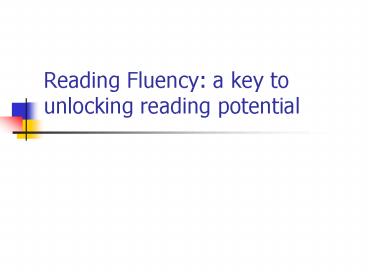Reading Fluency: a key to unlocking reading potential - PowerPoint PPT Presentation
1 / 16
Title:
Reading Fluency: a key to unlocking reading potential
Description:
Prosody. Comprehension at rate (Hudson, Mercer & Lane, 2000) What ... Prosody includes: Stress of words and syllables. Pitch rising and falling intonation ... – PowerPoint PPT presentation
Number of Views:100
Avg rating:3.0/5.0
Title: Reading Fluency: a key to unlocking reading potential
1
Reading Fluency a key to unlocking reading
potential
2
What is Fluency?
- National Reading Panel, 2000
- Fluency is the ability to read orally with
speed, accuracy and proper expression. - The Literacy Dictionary
- Fluency is the freedom from word
identification problems that might hinder
comprehension (Harris Hodges, 1995). - Logan (1997)
- The properties of fluent word recognition are
fast, effortless, autonomous, and unconscious.
3
Components of Fluency
- Rate
- Accuracy
- Prosody
- Comprehension at rate
- (Hudson, Mercer Lane, 2000)
4
What is reading rate?
- Reading rate is the fastest pace at which a
person can understand complete thoughts in
successive sentences of relatively easy material. - Oral reading rate
- Silent reading rate
5
What is accuracy?
- Accuracy is correctness in decoding. It is
measured by recording oral reading miscues. - We use accuracy is the following manner to help
us determine what reading material we should give
to students - Independent Level 98 or higher decoding
accuracy - Instructional Level 90 97 decoding accuracy
- Frustration Level below 90 decoding accuracy
6
What is prosody?
- Prosody is using your voice to convey meaning.
It is the expression with which you read. - Prosody includes
- Stress of words and syllables
- Pitch rising and falling intonation
- Juncture appropriate phrasing
7
Beginning vs. Fluent Readers
- Reading utilizes three basic processes
- 1. Decoding
- 2. Comprehension
- 3. Attention - The cognitive energy used in
mental processing tasks such as decoding and
comprehending---a resource available in limited
quantity.
8
Beginning Readers
- Beginning readers find that the dual tasks of
decoding and comprehending requires more
attentional energy than is available. - Use divide and conquer strategy complete one
task (decoding) before beginning the next
(comprehending). - Alternating between decoding and comprehension
places a heavy burden on memory, making reading a
slow and difficult process.
9
Fluent Readers
- Decoding is fast and easy automatic.
- (Students come to automatically recognize the
approximately 300 words that comprise 85 of the
words encountered in daily reading.) - Attentional resources can be devoted to
comprehension. - Students can decode and comprehend simultaneously.
10
Why is fluency important?
- There is a close relationship between fluency and
comprehension (National Assessment of Education
Progress, 1995). - The National Research Council report Preventing
Reading Difficulties in Young Children states - Adequate progress in learning to read English
beyond the initial level depends on sufficient
practice in reading to achieve fluency with
different text (223).
11
Why is fluency important?
- Low fluency results in less reading practice
- - Matthew Effect - rich get richer, poor get
poorer (Stanovich, 1986). - Fluency has a direct impact on work completion
- - ex. 2 hours of reading homework takes a
student three times as long if he is reading
three times slower than his classmates (60 wpm
vs. 180 wpm).
12
Methods of Fluency Instruction
- Explicit Instruction
- Guided oral readings (repeated readings)
- All repeated reading interventions showed clear
improvement between first and last readings (NRP,
2000). - Implicit Instruction
- Silent reading practice
- Silent reading should be paired with reading
conferences or logs for maximum benefit (NRP,
2000).
13
What are some ways to improve rate?
- Speed drills (with passages, words or sounds)
- Practice high frequency words
- Rapid word recognition charts
- Choral reading
- Neurological impress
- Repeated readings in pairs
- Taped books
- Great Leaps or Fast Forward
14
What are some ways to improve accuracy?
- Repeated reading in its various forms
- One to one corrective reading
- Taped text
15
What are some ways to improve prosody?
- Readers Theatre
- Choral reading
- Radio reading
- Phrase-cued text reading
16
What are some activities that improve all three?
- Teacher-modeled reading
- Choral reading
- Repeated reading
- Neurological impress
- Readers Theatre
- Phrase-cued text reading
- Previewing previewing
- Taped text

